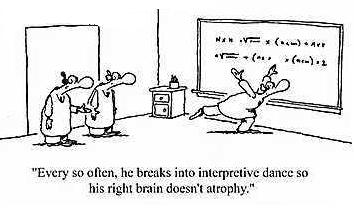Cases
Birth Trauma
“Mia always leaves with a smile and I don’t know where I would be today had I not taken her to Spinewave.”
 Again and again we iterate the importance of the upper neck at Spinewave. Your upper neck houses the brainstem which controls almost every natural function of the body: heart, lungs and bowels. For many it’s a difficult concept that tiny misalignments can wreak such havoc with the entire function of the body, even in young children. But they do.
Again and again we iterate the importance of the upper neck at Spinewave. Your upper neck houses the brainstem which controls almost every natural function of the body: heart, lungs and bowels. For many it’s a difficult concept that tiny misalignments can wreak such havoc with the entire function of the body, even in young children. But they do.
The trauma from birth can be the start of a lifetime of problems for many if cranial and spinal misalignments are not addressed sooner than later. There are many factors that contribute to birth trauma: a long labour, the use of drugs to increase contraction intensity, vacuum extraction or forceps, caesarean section because of lack of progress (as in this case), cord around the neck or incorrect positioning of baby during birth.
In a study by Guttmann1, a researcher who examined the effects of the birth process in more than 1000 infants, it was concluded that approximately 80% of all newborns had some form of nerve dysfunction. He commented that many health problems may arise from misalignments of the first vertebra in the neck, including lower resistance to infections of the ear, nose and throat. He noted, however, with the lightest pressure of the index finger (adjustment) to this bone, the infant’s clinical picture normalised.
Dr Abraham Towbin, a Harvard University pathologist, found evidence of spinal injuries as a result of the birthing process2. Brainstem and spinal injuries at birth were attributable to excessive pulling, bending and twisting, with subsequent bleeding into the space around the spinal cord being the most frequent indication of spinal injury. He reported that when this occurs, the nervous system’s respiratory centres are damaged, leading to respiratory depression, shock or even death.
Dr H Biedermann, a medical doctor from Belgium, who for over 40 years has advocated the importance of spinal examinations for newborns, found that strain of the muscles of the neck at the base of the skull were due to birthing injuries from prolonged labour and the use of extraction devices3.
 Undetected nerve dysfunction associated with birth trauma may result in4:
Undetected nerve dysfunction associated with birth trauma may result in4:
- Breathing weakness
- Irritability
- Vomiting
- Colic
- Sleeping problems
- Feeding problems
- Developmental delays
For more on the importance of the child’s upper neck and child wellness, click HERE.
Pregnant? If you are an expecting mum, click HERE.
Scheuermann’s Disease (hunchback)
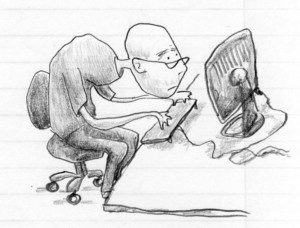 I heard about Dr Neil from a friend and my immediate response was: forget it, I’ve had enough of chiropractors – Peter.
I heard about Dr Neil from a friend and my immediate response was: forget it, I’ve had enough of chiropractors – Peter.
Scheuermann’s, or “hunchback”, is a developmental disease found in adolescents where spinal vertebrae become wedge-shaped rather than rectangular. The wedge-shaped vertebrae don’t stack straight and start to curve forward. The disorder is named after Dr Scheuermann of Denmark, who first recognised it.
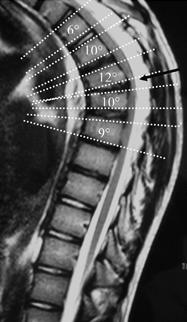 Nowadays people create their own version of Scheuermann’s Disease by hunching over computers, constantly playing with iPhones, or poor posture in general. This not only affects the shape and nature of the spine, but severely impacts the function of a very important part of the nervous system: the sympathetic nervous system.
Nowadays people create their own version of Scheuermann’s Disease by hunching over computers, constantly playing with iPhones, or poor posture in general. This not only affects the shape and nature of the spine, but severely impacts the function of a very important part of the nervous system: the sympathetic nervous system.
The sympathetic nervous system is also commonly known as the fight/flight system, associated with increased heart rate and adrenalin during emergencies. What is more commonly unknown though is that a thoracic spine which is not working properly, hunched over or “stuck” in certain places, is constantly activating the sympathetic nervous system in a manner one cannot feel.
An overactive sympathetic nervous system can cause hypersensitivities, allergies, anxiety, fatigue, depression or irritable bowel. It’s like the body is in a chronic state of emergency, without an emergency actually occurring.
 An obvious way to recognise a “runaway” sympathetic nervous system is blanching of the skin when depressed by fingers (right), redness, pimples, eczema or dermatitis. Blood vessels become flushed when the sympathetic nervous system is firing and this can be measured with thermographic technology to assess where potential disturbances are in the spine.
An obvious way to recognise a “runaway” sympathetic nervous system is blanching of the skin when depressed by fingers (right), redness, pimples, eczema or dermatitis. Blood vessels become flushed when the sympathetic nervous system is firing and this can be measured with thermographic technology to assess where potential disturbances are in the spine.
Midback pain is also a key indicator the thoracic spine is not working properly and probably activating the sympathetic nervous system. Problems in the thoracic spine can not only cause back pain, but also be a trigger of migraines, stiff neck and gut problems, i.e. constipation, gas, bloating or indigestion.
The following images are a separate case example of long-standing, chronic midback pain activating the sympathetic nervous system in a 31 year old female. Note the butterfly-shaped redness in the centre of the spine, and its resolution following 3 months of chiropractic care, demonstrating a much healthier nervous system. read more…
Gastro Oesophageal Reflux Disease
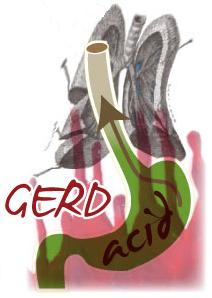 “My sternum no longer troubles me; my reflux and indigestion has subsided and my general health has improved.”
“My sternum no longer troubles me; my reflux and indigestion has subsided and my general health has improved.”
Gastro Oesophageal Reflux Disease (GERD) is when reflux is frequent enough to cause symptoms that reduce well being. It occurs when the lower oesophageal sphincter allows the acid stomach contents back up towards the throat. The pressure of this sphincter needs to be greater than the pressure in the stomach. There are two distinctions in lower oesophageal sphincter tone when considering whether you have GERD or not – and they make a difference: 1. Myogenic tone, and 2. Neurogenic tone.
Myogenic tone refers to the condition of the smooth muscle of the sphincter itself. A person should be able to stand upside down after a large, hearty meal and have no food back up into the oesophagus or mouth. Sometimes this muscle is damaged through acidic damage or when the intraabdominal pressure overcomes the natural reflex of the sphincter to close. Long term damage to the muscle may result in an impasse to a solution, besides surgery perhaps.
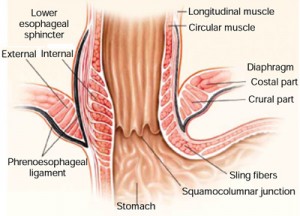 The contraction or relaxation of the sphincter muscle is also due to a multitude of chemicals and hormones. Some chemicals are harmful. To name a few that play a role in opening or closing the lower oesophageal sphincter: Dopamine (feeling good or bad, basal ganglia damage), histamine (allergy drugs, sensitivity problems), pain killers, progesterone (oral contraceptives), serotonin (antidepressants), glucagon (blood sugar problems), substance P (pain). It’s not as straight forward as simply taking Losec for the rest of your life.
The contraction or relaxation of the sphincter muscle is also due to a multitude of chemicals and hormones. Some chemicals are harmful. To name a few that play a role in opening or closing the lower oesophageal sphincter: Dopamine (feeling good or bad, basal ganglia damage), histamine (allergy drugs, sensitivity problems), pain killers, progesterone (oral contraceptives), serotonin (antidepressants), glucagon (blood sugar problems), substance P (pain). It’s not as straight forward as simply taking Losec for the rest of your life.
Neurogenic tone refers to the neuromuscular mechanisms that maintain tonic or reflex contraction of the sphincter, essential for its antireflux behaviour. Impairment of these mechanisms promotes gastro oesophageal reflux and – like so many conditions when considering function as opposed to disease – is often overlooked when considering the person as a whole. read more…
Stress
“Chiropractic is as valuable to our family care as our GP.”
 I first came to Neil after hearing him speak about managing stress through chiropractic care 3 years ago. Anything that helps me manage running two businesses and raising a young family immediately appeals to me. Spinewave educated me to understand how my workload and every demand on life puts stress on my nervous system, which interferes with the brain’s ability to communicate messages clearly. Neil showed me, very tangibly how this works. After assessing my physical state, he made me raise each leg and hold it up while he applied downward pressure; I could not hold my left leg up at all. He carefully assessed my upper neck and made a small adjustment, and just like that the “block” was cleared and I had full control over my leg. My brain could communicate with my body once again.
I first came to Neil after hearing him speak about managing stress through chiropractic care 3 years ago. Anything that helps me manage running two businesses and raising a young family immediately appeals to me. Spinewave educated me to understand how my workload and every demand on life puts stress on my nervous system, which interferes with the brain’s ability to communicate messages clearly. Neil showed me, very tangibly how this works. After assessing my physical state, he made me raise each leg and hold it up while he applied downward pressure; I could not hold my left leg up at all. He carefully assessed my upper neck and made a small adjustment, and just like that the “block” was cleared and I had full control over my leg. My brain could communicate with my body once again.
I had also always fobbed off a frequent twinge in my shoulder and painful muscle spasms as one of those random pains that you just have to put up with; or exaggerated emotional responses put down to a stressful workload that I had little control over.
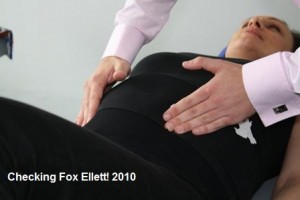 I am now in tune with my body: that random shoulder twinge is actually not so random. Like clockwork, when my work pressure increases, my shoulder starts to twinge. If I ignore it, it gets worse. Before being treated by Spinewave, I would let this go until the pain shot all the way down my arm. I would then resort to physio treatment, not really knowing what other options I had. Physio would take at least 6 sessions of slow recovery. Now I see Neil, I get immediate relief (no more than 2 or 3 adjustments) to being fully functional again, and each adjustment is almost half the cost per treatment that I paid before. read more…
I am now in tune with my body: that random shoulder twinge is actually not so random. Like clockwork, when my work pressure increases, my shoulder starts to twinge. If I ignore it, it gets worse. Before being treated by Spinewave, I would let this go until the pain shot all the way down my arm. I would then resort to physio treatment, not really knowing what other options I had. Physio would take at least 6 sessions of slow recovery. Now I see Neil, I get immediate relief (no more than 2 or 3 adjustments) to being fully functional again, and each adjustment is almost half the cost per treatment that I paid before. read more…
Scoliosis
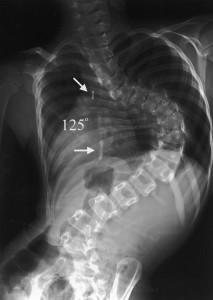 “I was truly shocked when I saw the x rays but it certainly explained my problems.”
“I was truly shocked when I saw the x rays but it certainly explained my problems.”
So often I’ve heard from clients that a therapist of some description has run their fingers down their spine and told them they have scoliosis. This is not how you define scoliosis. It’s defined by x ray only and the curvature has to be more than 10 degrees.
Spinal fusion started becoming popular in the 1900s. And then by the mid-1900s Harrington rods were introduced by Paul Harrington. In all this time, cutting the spine open and fusing bones together still seems like the logical first step to people with back pain – costing ACC hundreds of thousand of dollars every year – even in light of the spine being the key signalling device for the central nervous system to maintain harmony within the body. Some research has even suggested that scoliosis might manifest itself due to lesions in the posterior columns of the nervous system during the early years. This central nervous system dysfunction was hypothesised to be a decreased vibratory sensation1,4. So as a side note: Adjust the child.
For the brain to be aware of its internal and external environment, and to lead adequate self-directed healing, the spine needs to be mobile.
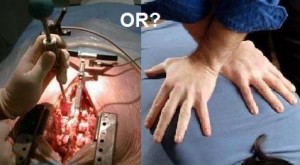 The risks of surgery become quite overwhelming: Neurological damage, loss of normal spine function, additional strain on unfused vertebrae, excruciating post-surgical pain (sometimes only a year down the track), infection, and in the instance of scoliosis, further curvature progression. Due to these complications, re-operation is necessary, sometimes referred to as reconstructive, re-corrective, revision, or salvage surgery. Complication rates vary, but failure of fusion has been found in more than 50% of treated patients and among 25 adult patients, 40% required salvage surgery2. What we know now, from a patient’s perspective at least, is the preferred plan of action would likely be avoiding unnecessary risk, i.e. avoiding surgery (or keep it as the final option) once all conservative measures have failed.
The risks of surgery become quite overwhelming: Neurological damage, loss of normal spine function, additional strain on unfused vertebrae, excruciating post-surgical pain (sometimes only a year down the track), infection, and in the instance of scoliosis, further curvature progression. Due to these complications, re-operation is necessary, sometimes referred to as reconstructive, re-corrective, revision, or salvage surgery. Complication rates vary, but failure of fusion has been found in more than 50% of treated patients and among 25 adult patients, 40% required salvage surgery2. What we know now, from a patient’s perspective at least, is the preferred plan of action would likely be avoiding unnecessary risk, i.e. avoiding surgery (or keep it as the final option) once all conservative measures have failed.
While mechanical medicine was making its surgical advances in the 1950s, so too was chiropractic. The developer of chiropractic after his father, BJ Palmer, reported on a case of scoliosis in 1951 amongst his extensive plethora of research. BJ Palmer also had at that time, the biggest collection of pathological and anomolous bones in the world. BJ reported 4,392 total specimens, containing 13,697 skeletal elements. It was estimated that these 4,392 specimens represented approximately 3,000 persons. BJ Palmer assembled the Osteological Studio in a room for student study. Even then, the collection was known to the professors of anatomy in many of the nearby state medical colleges. These specimens were available to them and were often studied by them to better qualify them for carrying on their lecture work in their own classes. read more…
Brain Fog
 “I had not been sleeping well, suffered from headaches, and generally felt drained with a constant sense of doom and what I call ‘fogginess’ most of the time. I never thought for one moment that chiropractic work could be of help.”
“I had not been sleeping well, suffered from headaches, and generally felt drained with a constant sense of doom and what I call ‘fogginess’ most of the time. I never thought for one moment that chiropractic work could be of help.”
Brain fog is an unofficial diagnosis for poor concentration, lack of mental clarity, inability to focus, indecision or forgetfulness. The term I like to use more is a sense of disconnectedness.
Disconnectedness implies a cognitive dissonance between thought and behaviour; and a dissonance between perception and reality. When perception of body or emotion is distorted, you may feel something, but that’s not what’s really going on.
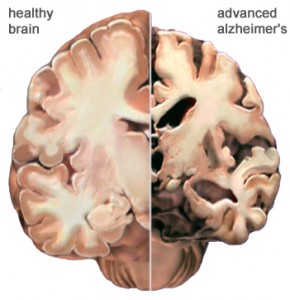 There could be a hundred-and-one physiologic reasons for brain fog ranging from toxic, to neurologic, vascular, hormonal, infectious, traumatic or elemental deficiency. However, in context of “fogging of the brain” in relatively normal people – giving the definition of “normal people” a wide berth itself – all roads lead to brain. So we can look at the brain becoming fogged because of its inability to maintain normal cortical function.
There could be a hundred-and-one physiologic reasons for brain fog ranging from toxic, to neurologic, vascular, hormonal, infectious, traumatic or elemental deficiency. However, in context of “fogging of the brain” in relatively normal people – giving the definition of “normal people” a wide berth itself – all roads lead to brain. So we can look at the brain becoming fogged because of its inability to maintain normal cortical function.
The cortex is the outer layer of the brain that requires constant stimulation to keep us engaged in life. It’s where our higher “human” functions come from. The cerebral cortex is also the area that becomes damaged, shrinks and dies in the process of Alzheimer’s Disease, which would obviously be an extreme case of brain fog.
For optimal performance on a day to day basis, the cortex requires the appropriate amount of “arousal” to keep it stimulated in a positive fashion. This can also be called eustress: the right amount of stress which is healthy and promotes learning and growth. When the cortex becomes overstimulated, or over-stressed, this is called distress and has a negative impact on its function and performance. Finding balance is the key.
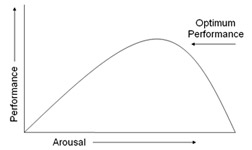 Arousal is a term that can be used to describe a level of physiological activity in the body leading to activation of the cortex, because all roads lead to brain. The inverted-U theory states that as arousal increases, so too does performance, up to a point where further increases in arousal cause performance to decrease (see graph).
Arousal is a term that can be used to describe a level of physiological activity in the body leading to activation of the cortex, because all roads lead to brain. The inverted-U theory states that as arousal increases, so too does performance, up to a point where further increases in arousal cause performance to decrease (see graph).
The challenge with modern day society is that we’re over-stimulated, most of the time, beyond the point of optimum performance for the brain. Especially when we’re setting big challenges for ourselves with high expectations, or simply trying make ends meet. Either end of that challenge spectrum eventually ends in burn out unless managed properly. As the curve begins to dip over the other side, signs and symptoms of stress start to manifest in the form of pain, skin or gut problems, fatigue, moodiness or brain fog. And then if cortex is pushed too far, anxiety and panic set in.
The trouble with an “unofficial diagnosis” like brain fog is that it presents with “unofficial symptoms”, from “unofficial causes” like an over-stimulated cortex, which obviously won’t be detected in a blood test. So how do we figure it all out and correct the problem? As the Germans would say: We have ways and means. read more…
Vertigo
“My doctor told me that things would settle down eventually. They did not.”
Previously I had written on dizziness as it relates to eye reflexes and blood pressure. This case will briefly highlight the difference between central vertigo and peripheral vertigo.

Peripheral vertigo is the most common go-to set of diagnoses when someone starts spinning: Meniere’s Disease, otitis media, labrynthitis, benign paroxysmal positional vertigo, viral infection or maybe acoustic neuroma. Peripheral refers to the inner ear region (on the periphery of the head).
Central vertigo would probably be the most likely cause of vertigo for the average person, yet, ironically, the most commonly overlooked. Central refers to neurological disruption in the centre line: brain, brainstem and spine. These 3 things are the functional units which come under the most strain on a day to day basis because of the way we stress and hold our posture. Balance and equilibrium is perceived at the levels of cerebellum and brainstem and they can receive “snowy TV” disturbance from both ends – the brain and eyes above, or spine and body below.
Central vertigo can also cover the third area of vertigo, which relates to systemic problems like blood pressure, blood sugar levels, heart conditions, or psychiatric issues.
Within the inner ear there are various bits and pieces that keep us on the level: Cochlea, semicircular canals and otolithic organs. The cochlea interprets sounds while the canals and otolithic organs are responsible for balance and awareness of position. The otolithic organs detect how fast or slow you’re moving in the vertical and horizontal planes, while the semicircular canals detect angular acceleration with the fluid that moves inside them. In a nanosecond, your brain can work out the angular acceleration of your head and where you are in the world with equations like this, which used to take me hours in engineering school. The brain’s depth of instantaneous computational powers is truly amazing.
What is also truly amazing is the functional design of the semicircular canals that report this information back to the brain in order for these calculations to be performed. There are 3 canals, almost precisely perpendicular to each other in each plane (x, y and z), and each canal detects angular acceleration in its plane. The wisdom of the body didn’t create these haphazardly and place them at random angles, hoping for the best so you don’t fall over. As with most things in nature, there was intent in creation. read more…
Hemisphericity
 I have been experiencing a raft of unusual symptoms including sensations in my face, nausea, irritable bowel, tinnitus, a large numbers of floaters in my eyes and more recently, constant pins and needles in my feet and sometimes my hands. My husband is a chiropractor, so it has been frustrating that the techniques he uses weren’t making headway with my condition.
I have been experiencing a raft of unusual symptoms including sensations in my face, nausea, irritable bowel, tinnitus, a large numbers of floaters in my eyes and more recently, constant pins and needles in my feet and sometimes my hands. My husband is a chiropractor, so it has been frustrating that the techniques he uses weren’t making headway with my condition.
The traditional concept of hemisphericity (now false) refers to the idea that people may rely on a preferred mode of cognitive processing, which is linked to activity in the left or right cerebral hemisphere.
Modern concepts in functional neurology, which describe hemisphericity as differing firing rates between the left and right sides of the brain. With various kinds of stress placed upon the body and brain – some as simple gravity – there will be a lower performing cerebral cortex and a higher performing cerebral cortex. According to Roger Sperry, the 1981 Nobel prize winner for brain research, a large proportion of the brain’s output is directed simply towards maintaining your body posture in its gravitational field, which is why posture is so important to maintain a healthy brain.
The left brain tends to be the “accelerator” of the body, whereas the right brain tends to be the “brake” system. If the brakes cannot be applied, we have a runaway nervous system with everything that would imply: allergies, overactive immune activity, hypersensitivity reactions and emotional instabilities. A left brain hemisphericity would mean a decreased accelerator, so we would think of conditions whereby the body or brain would not be stimulated enough, e.g. depression.
The cortex is also responsible for inhibiting our “primal brain”, the brainstem. The brainstem regulates the fight/flight response through the thoracic spine. So if a stressed individual is beginning to exhibit signs of hemisphericity, their fight/flight response will be elevated and will present as ulcers, reflux or irritable bowel syndrome. The cortex controls motor output to muscles too, so hemisphericity can create pain syndromes on one side of the body over time like carpal tunnel syndrome, Golfer’s elbow or sciatica.
Correction of hemisphericity is achieved by the two hemispheres of the brain reaching temporal coherence, i.e. firing at a similar rate and in harmony with each other. The role of upper cervical specific in hemisphericity is critical when choosing where and why to adjust on any given day; as well as incorporating similar non-invasive neurological stimulation such as specific limb adjusting, light, balance, magnets and supplementation.
Recent award-winning research has shown that the process of a chiropractic adjustment is like rebooting a computer. EEG signals prove that there are definite changes to the way the brain processes information after chiropractic care.
Correction doesn’t happen overnight though. Brain plasticity is a long process (how long did it take to reach that point in the first place?). Sally and I spent countless hours together working on many things. How do you know whether you might have hemisphericity? Read through the check list below ? read more…
Irritable Bowel Syndrome
 I am now well toilet trained – Karen.
I am now well toilet trained – Karen.
Irritable bowel syndrome (IBS) has in many instances become a hand-wave diagnosis due to its complex nature and myriad causes. IBS can have elements of constipation and diarrhoea, or alternation between the two.
When I first heard that psychological counselling was a good treatment for IBS, I was intrigued by the gut-brain axis; and what conclusions to draw from so many people having constipation or diarrhoea as a side issue with their other neurological complaints.
“Gut decisions” probably involve the enteric (bowel) nervous system to some degree, and explains why when you’re nervous you get “butterflies”. IBS is believed to stem from miscommunication between the central (brain) and enteric nervous systems. More specifically, an inhibition of the corticolimbic system, which means emotional dysregulation. There may be other intraluminal factors like abnormal gut flora and the popular gluten intolerance, but these probably tie back into dysregulation of the neuroimmune connection, most likely broken down by the primary cause of psychosocial stress.
Changes in mood, immune and gut function are among the first things to alter in the breakdown of nervous system function. In IBS patients, brain imaging shows that areas most activated include thalamus, insula, anterior cingulate cortex, amygdala, and brainstem (upper spine). As per the diagram below, the green areas represent the parts of the “automatic” nervous system which attempt to maintain harmony in the body. The red arrows show how these parts control gut function and, interestingly, skin (see psoriasis). One of chiropractic’s main objectives is to normalise the green areas. This is done by analysing the spine via neurological exam, measuring the autonomic nervous system, and providing correct stimulation by way of adjustment ? read more…
Happiness
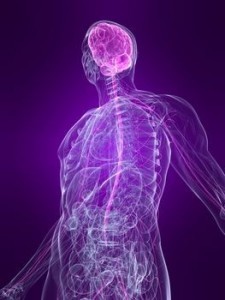 “I wanted to be a happier person.”
“I wanted to be a happier person.”
Happiness is not only a state of mind. It’s a state of body and spirit, because you feel sadness, doubt, disappointment, anxiety and fear in every cell of your being when things are not right. People’s eyes never lie and when the hole is so deep, it becomes a near impossibility to “think” your way out. Usually thinking makes it even worse. I’ve been in that hole more times than I care to imagine and, personally, without my various chiropractors/mentors/counsellors over the last 10 years, my body and mind would have given up the fight a long time ago.
When I really began to understand the power of chiropractic and its influence on the brain, I started a presentation with “a change of physiology is faster than anything you can think yourself into”. A perpetual state of no joy in whatever form it manifests, at a fundamental level, has come about through the brain (frontal cortex) no longer firing on all cylinders. It’s been worn down through so much stress and one event after another that it’s become nothing more than a sparkler in the rain. Neurochemistry depletes. This then starts affecting energy levels, gut function, immune function, and outward behaviour. For more, go to Mental Wellness.
I’ve never felt it right to say that people should be happy in spite of their circumstances. I think that’s bollocks. Circumstances have a massive impact on our mental health when they’re beyond control. But what one can do is seek out help and strategies to navigate through to the other side. The good news is, is that the cortex can have jumper leads hooked up to it and restarted. The journey to happiness can be short circuited in spite of one’s thinking mind – but it is the thinking mind that will continue the momentum. Chiropractic, amongst other things, can be a catalyst if we understand how the brain and spine works. read more…
Anxiety
 “Anxiety for me is the fear… the fear that despite the effort I put in, there is still lack. Coming to Spinewave has allowed me to let go of a fair portion of those anxieties.”
“Anxiety for me is the fear… the fear that despite the effort I put in, there is still lack. Coming to Spinewave has allowed me to let go of a fair portion of those anxieties.”
This is one of those topics you won’t understand unless you’ve truly experienced it yourself, or you’ve lived with someone with anxiety for quite some time. This will also be the first time I’m sharing my own story coupled with a case.
One morning a few years ago, around ten o’clock, I found myself collapsed and shaking on the kitchen floor. Sobbing, hyperventilating, cold, stiff, and it felt like my heart was going to break through the wall of my chest. I had never experienced anything like it and had no idea what was happening to me. My vision narrowed to a tunnel and it took a couple minutes to regain my senses and slowly sit up, stabilise my breathing and think clearly.
I’ve only had a handful of major anxiety attacks like that since, but there have been a score of aftershocks. The problem, and beauty, with the brain, emotional cortex, amygdala and various other bits and pieces, is that emotional experiences are seared into its living matrix to be continually revisited until the synapses are broken and rewired. To start that process you need simply to understand who and what you are, and what is happening.
Anxiety has presented to me in practice countless times in the form of numbness, tingling, pain, palpitations, abnormal breathing, insomnia, blackouts, tension, seizures, burnout, adrenal fatigue, headaches and all the mood disorders that hold anxiety’s hand, like OCD or depression. Personal experience has been the only factor in making the differentiation between mind and body, and implementing the appropriate strategies to deal with anxiety because oftentimes people will be sent away from practitioners with the diagnosis of “there’s nothing wrong with you”. Obviously though if there’s a problem… there’s a problem.
Anxiety is based largely in the realm of irrationality and the illogical – but it’s real to the person who experiences it. The world continues to turn but for the anxious mind, it stops. The world pauses and the imagination takes over in that gap, wreaking havoc with the monsters under the bed it creates. Part of the problem is that the world is turning faster than it used to. And as it spins it opens holes we think need to be filled, creating a sense of lack in our lives: We’re not good enough; we don’t have enough; we’re not achieving enough; we will never be enough; or just that it’s all going to come crashing down. From the lack come the triggers for the anxious mind – the thoughts and behaviours which set it off on a path of neurological hard-wiring. The idea that this process can begin in childhood should come as no surprise.
Anxiety opens these holes and our wholeness is never realised. The rift between desire and lack gets bigger. Problems become insurmountable and soon any activity of daily living in work or relationships can become triggers when they never used to be. Your loved one seems to have… “changed”. I describe it as whirlpools of fixation. The stream of consciousness in one’s mind used to be a pleasant bubbling brook but now there are whirlpools of particular thoughts that circle the drain over and over and over because we never let go, and let them get sucked out. The damage this can create to oneself and loved ones is immense.
We forget to realise that we are more than this. That “this” – whatever is going on in our life – is separate from who we are. We lose sight of the whole by only seeing the hole. read more…
Neck pain and cerebellar control
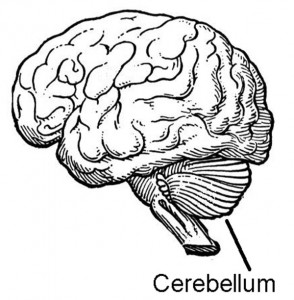 “My most significant problem used to be walking across the road and getting caught out by a car coming faster than anticipated.”
“My most significant problem used to be walking across the road and getting caught out by a car coming faster than anticipated.”
Part of my job is to connect the dots for people, and so I’ve had this one in the archives for a while and thought it opportune to point out the seemingly miraculous implications of an adjustment that we would otherwise gloss over.
At face value one would read this and see: Man has accident; man gets neck pain; man goes to chiropractor; chiropractor fixes neck pain. And the perception that chiropractic is only good for neck or back pain would continue to persist.
Upon closer inspection, over the course of about a year, Warren’s cerebellum was reprogrammed to a level of function that its connection with the brain could perceive speed and timing, anticipate, initiate and recalibrate appropriate movement. Stuff usually taken for granted until that ability is depreciated and you start having trouble crossing the road!
The cerebellum is important for movement control and plays a particularly crucial role in balance and locomotion. As such, one of the most characteristic signs of cerebellar damage is walking ataxia (see previous cerebellar case here). The cerebellum constitutes only 10% of the total volume of the brain but contains more than half of all its neurons. It’s believed that the cerebellum also plays a role in fine tuning emotion with the limbic cortex. So since the majority of its information input comes from the spine and spinal cord, when the neck is out of whack, people are not always going to behave appropriately and movement is going to be compromised over time.
Neural reprogramming through regular adjusting doesn’t always bring the feel-good factor that massage may do, for instance. But when you look back over time and see how the system is functioning at a completely different level, its effects are longer lasting. The cerebellum has to co-ordinate the flow of information coming in and going out of the brain and make adjustments to the required action, like initiating a sprint across the road. It’s important in maintaining posture, calibrating eye movement and keeping us steady – a super important bit of the brain and one well maintained through good chiropractic care. read more…


